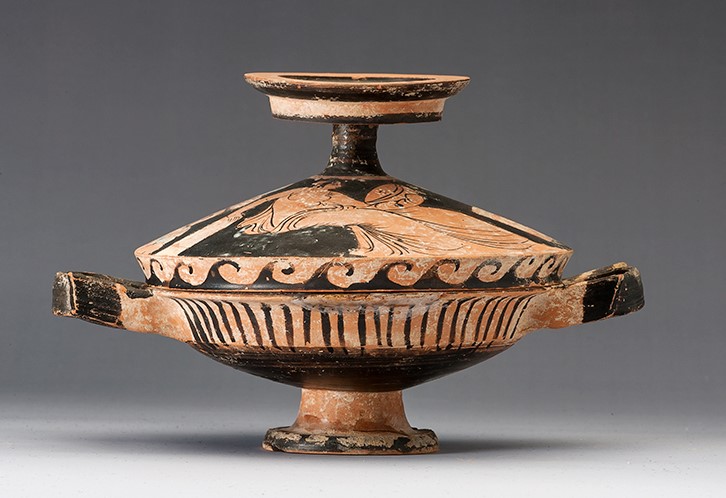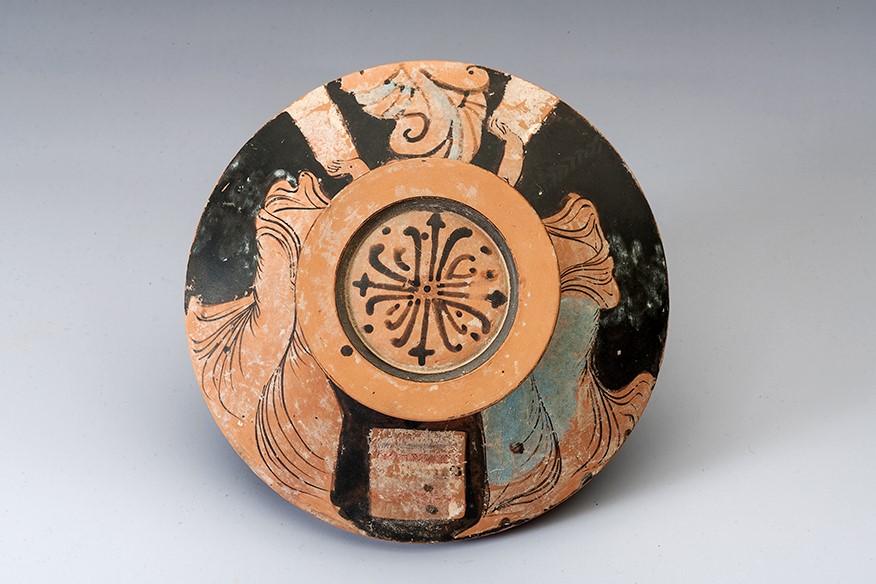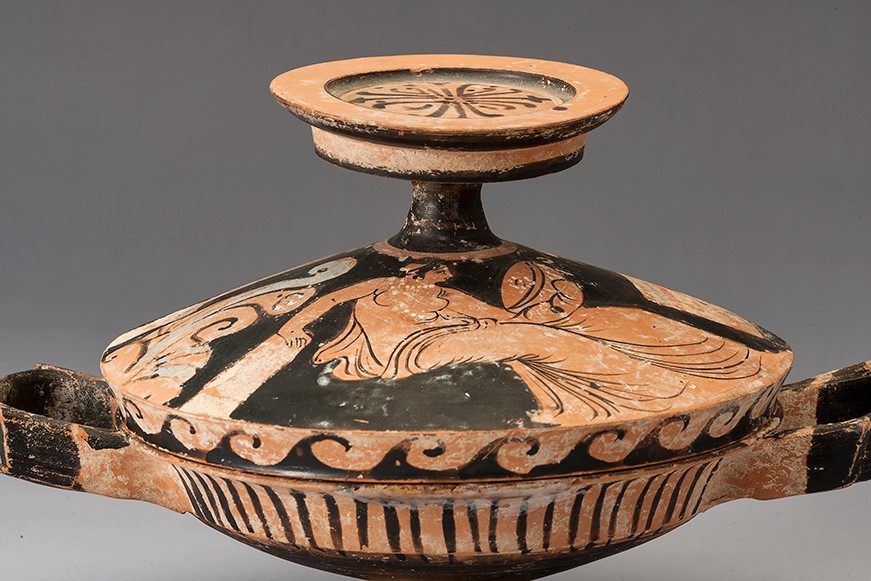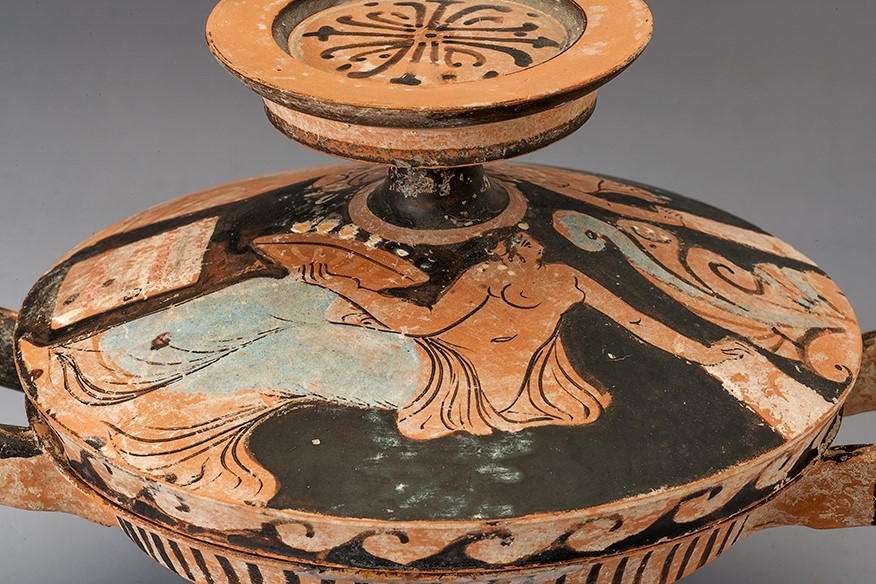Acquisition number: 1976.12
On the lid are drawn two seated women, the one sitting to the right and holding a tympanon, the other to the left and holding a dish containing offerings. Each leans back to rest one hand on a pillar. Between the women's feet stands an altar and behind them a palmette with floral. Blue is added for the drapery of the woman with the dish and for some of the palmette leaves; bands of red on the altar; white for many of the details such as the women's necklaces and for the strings of amulets about their chests, the decoration and strings of the tympanon, the rocks they sit on and the pillars they lean on. On the top of the handle is a black-figure palmette scheme; around the edge of the lid, wave pattern. The inside of the lid is not painted.
The body has a streaky wash inside. On the outside, in the handle zone, vertical strokes; the handles themselves had their ends dipped in glaze. The vertical edge of the foot is black, the underside reserved.
Title: Sicilian Red-Figure Lekanis and Lid - 1976.12
Acquisition number: 1976.12
Attribution: Canberra Group.
Author or editor: J.R. Green
Culture or period: Sicilian Red-Figure.
Date: c. 325-310 BC.
Material: Clay - Terracotta
Object type: Vessels - Dish/plate
Dimensions: 160mm (w) × 142mm (h)
Origin region or location: Italy
Origin city: Sicily
Display case or on loan: 4
Keywords: Sicilian, Red Figure, Canberra Group, Zurich Group
A.N.U. News 34, 1959, 23 fig. 5; A.D. Trendall, Greek Vases in University House (Canberra 1960) fig. 5; The Red-figured Vases of Lucania, Campania and Sicily i-ii (Oxford 1967) 632, no. 310, pl. 247, 1-2; J.R. Green with B. Rawson, Catalogue of Antiquities in the Australian National University, A.N.U. (Canberra, 1981) 69.
1976.12
Sicilian Red-Figure Lekanis and Lid
Lent by University House to which it was presented by Professor A.D. Trendall. Total ht 14.2cm; ht of lid 7.9cm; diam. lid 16cm; ht of bowl 7.2cm; diam. bowl 16cm.
Intact but for the foot which has been broken and rejoined. Brown-buff clay; dull glaze.
On the lid are drawn two seated women, the one sitting to the right and holding a tympanon, the other to the left and holding a dish containing offerings. Each leans back to rest one hand on a pillar. Between the women's feet stands an altar and behind them a palmette with floral. Blue is added for the drapery of the woman with the dish and for some of the palmette leaves; bands of red on the altar; white for many of the details such as the women's necklaces and for the strings of amulets about their chests, the decoration and strings of the tympanon, the rocks they sit on and the pillars they lean on. On the top of the handle is a black-figure palmette scheme; around the edge of the lid, wave pattern. The inside of the lid is not painted.
The body has a streaky wash inside. On the outside, in the handle zone, vertical strokes; the handles themselves had their ends dipped in glaze. The vertical edge of the foot is black, the underside reserved.
About 325-310 BC. This is the name vase of the Canberra Group which belongs within the Zurich Group of later Sicilian red-figure. Trendall pointed out that it is particularly close to Syracuse 46882 by the Painter of Catania 4295 (A.D. Trendall, The Red-figured Vases of Lucania, Campania and Sicily i-ii [Oxford 1967] pl. 246, 7-8): note the s-curve of the nearer legs and the drawing of the drapery. The large bodies and small heads are typical of this stylistic area. One notes that the woman holding the tympanon has her left arm enclosed in the folds of her himation.
Compare the form of the palmette between the women, and its bell-flower, with those to either side of the woman on the front of the Campanian bell-krater 1967.10.
The shape is a very common one in later Sicilian red-figure.
Although Trendall successfully isolated the main stylistic groups, there remain major difficulties in identifying the centres of manufacture of Sicilian red-figure. There has nonetheless been useful work in exploring the relations with Paestan and Campanian. Recent publications include L. Bernabò Brea and M. Cavalier, La ceramica figurata della Sicilia e della Magna Grecia nella Lipàra del IV sec. a.C. (Muggiò [Milano] 1997); S. Barresi and S. Valastro, Vasi attici figurati. Vasi sicelioti. Le collezioni del Museo Civico di Castello Ursino a Catania (Catania 2000) and Barresi’s articles “Ceramica figurata siceliota dalla città e dalla Chora di Adranon. Documenti e riflessioni”, Melanges d’Archéologie et d'Histoire - Antiquité 114, 2002, 611-653, and “Teseo, Sini, Melicerte ed il Pittore della Scacchiera”, Ostraka 11, 2002, 55-79; H. Cassimatis, “Survol de la céramique à figures rouges sicéliote”, Pallas 60, 2002, 283-291; A. De Filippis, “Da Lipara a Cuma: un itinerario fra Sicilia, Eolie e Campania settentrionale”, Rivista dell'Istituto Nazionale d'Archeologiae Storia dell'Arte 19-20, 1996-1997, 21-48; F. Giudice, “La ceramica attica del IV secolo a.C. in Sicilia ed il problema della formazione delle officine locali”, in: N. Bonacasa, L. Braccesi and E. De Miro (eds), La Sicilia dei due Dionisî. Atti della settimana di studio, Agrigento, 24-28 febbraio 1999 (Progetto Akragas 2, Rome 2002) 169-201; U. Spigo, “Breve considerazioni sui caratteri figurativi delle officine di ceramica siceliota della prima metà del IV secolo a.C. e alcuni nuovi dati”, ib., 265-293; id., “Composizione e racconto: documenti di cultura pittorica nella ceramica siceliota del IV secolo a.C. dalla necropoli di Lipàra”, in: M. Barra Bagnasco and M.C. Conti (eds), Studi di Archeologia Classica dedicati a Giorgo Gullini per i quaranti anni di insegnamento (Alessandria 1999) 175-195; id., “Rapporti tra Lipari e l’area dello Stretto di Messina nel IV sec. a.C. e nella prima età ellenistica: alcune testimonianze archeologiche”, in: B. Gentili and A. Pinzone (eds), Messina e Reggio nell'antichità: storia, società, cultura. Atti del Convegno della S.I.S.A.C. (Messina – Reggio Calabria, 24-26 maggio 1999) (Messina 2002) 47-77.
A.N.U. News 34, 1959, 23 fig. 5; A.D. Trendall, Greek Vases in University House (Canberra 1960) fig. 5; The Red-figured Vases of Lucania, Campania and Sicily i-ii (Oxford 1967) 632, no. 310, pl. 247, 1-2; J.R. Green with B. Rawson, Catalogue of Antiquities in the Australian National University, A.N.U. (Canberra, 1981) 69.
University House, ANU.
1 Balmain Cres, Acton ACT 2601.
(02) 6125 5211.



